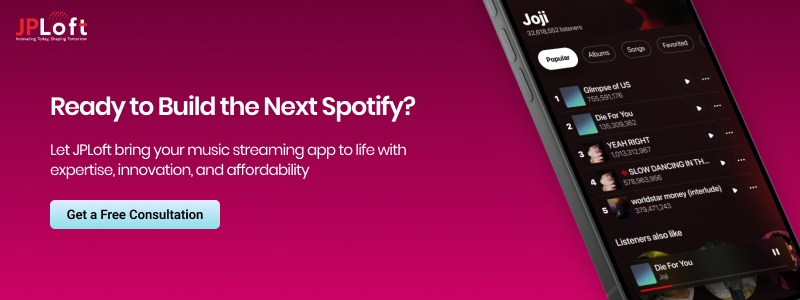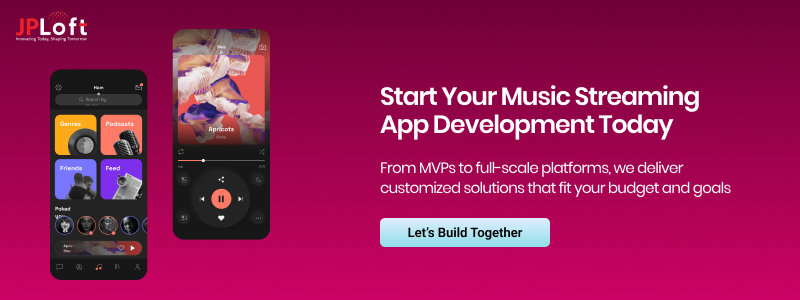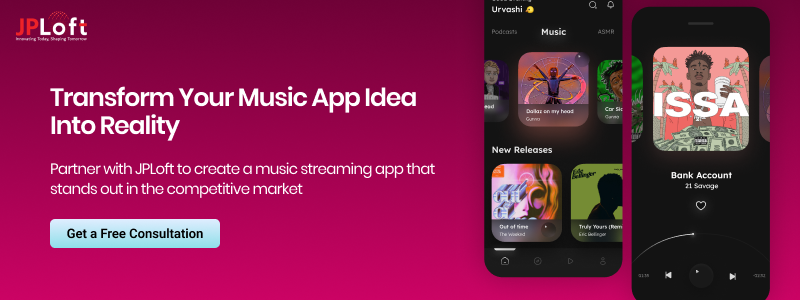Thinking about creating a music streaming app? Here’s the big question: how much does it actually cost?
The music streaming app development cost typically falls between $25,000 and $150,000. The range depends on the features, complexity, and team you choose.
But there’s more to this than just numbers.
With the demand for personalized audio experiences skyrocketing, building a music streaming app is a decision that could put you at the center of a booming market.
Let’s explore why 2025 is the perfect time to invest in this space and understand the costs in greater detail.
Ready to dive in? Keep reading.
Should You Build a Music Streaming App in 2025?
Short answer? Absolutely!
Let’s break it down with three compelling reasons to build a music streaming app:
► The Market Is Exploding
The music streaming industry is on a steep upward trajectory.
Global revenue is expected to cross $90 billion by 2030, and 2025 will be a pivotal year in that growth.
Users are shifting away from traditional downloads and CDs, opting for the ease of streaming platforms that offer curated playlists, recommendations, and on-the-go access.
With the market ripe for innovation, it’s a prime opportunity to carve out your space.
► Endless Revenue Possibilities
Music streaming apps don’t just rely on one income stream.
• Subscriptions: Offer premium plans for ad-free, high-quality audio.
• Advertisements: Monetize free users through targeted ads.
• In-App Purchases: Sell curated playlists, exclusive content, or even merchandise.
These revenue models not only keep your app sustainable but also allow you to scale effortlessly.
► Game-Changing Technologies
Tech innovations are setting the stage for more interactive and personalized music experiences.
• AI-Powered Recommendations: Keep users hooked with music that matches their preferences.
• Immersive Sound Tech: Create unforgettable listening experiences with 3D audio.
• Cross-Platform Integration: Let users switch seamlessly between devices without losing progress.
With these tools at your disposal, your app can stand out in an already competitive market.
So, should you build a music streaming app in 2025? The answer is a resounding yes. The timing, technology, and market conditions couldn’t be better to hit the right note.
Average Cost to Develop a Music Streaming App in 2025
So, it’s time to ask the big question.
How much does it cost to build a music streaming app?
The cost to build a music streaming app ranges from $25,000 to $150,000, depending on the complexity and features you choose.
While a basic app might be enough to get started, scaling to meet user expectations often requires additional investment.
For instance, a simple app with core features like playlists and music catalogs may cost around $25,000 to $50,000.
However, if you’re aiming for something more sophisticated like offline playback, personalized recommendations, and multi-device support the costs could climb to $50,000 to $80,000.
High-end apps, incorporating features such as live streaming, AI-powered suggestions, and advanced analytics, might stretch your budget beyond $80,000.
The final cost also depends on factors like the size of your development team, the technology stack used, and the platforms you target.
Whether you focus on iOS, Android, or both can significantly impact the cost of music streaming app development.
Here’s a quick app development cost breakdown to help you plan:
|
App Complexity |
Features Included |
Estimated Cost |
|
Basic App |
User accounts, playlists, basic music catalogs |
$60,000 - $100,000 |
|
Mid-Tier App |
Offline mode, AI recommendations, multi-device sync |
$120,000 - $180,000 |
|
High-End App |
Live streaming, advanced analytics, social sharing |
$200,000 - $250,000+ |
Starting with a minimum viable product (MVP) is often a smart way to balance costs while ensuring a functional launch.
For a more detailed answer, you can contact a mobile app development company, they will be able to give you a detailed breakdown of cost along with a quote.
Factors That Affect the Cost to Build a Music Streaming App
Here’s a deeper dive into the key factors that influence the cost to create a music streaming app, complete with detailed tables summarizing costs for each aspect.
1. Features and Functionalities
The choice of features determines not only your app’s functionality but also its appeal in the market.
Basic features are essential for functionality, while advanced and premium features enhance user experience and differentiate your app from competitors.
|
Feature Category |
Features |
Cost Estimate |
|
Basic |
User registration, playlists, music catalogs |
$20,000 - $40,000 |
|
Advanced |
Offline downloads, AI recommendations |
$40,000 - $70,000 |
|
Premium |
Live streaming, AR/VR integration, advanced analytics |
$80,000 - $100,000+ |
For instance, adding AI-powered recommendations similar to Spotify requires machine learning algorithms that increase both time and cost.
But they significantly boost user engagement by offering tailored content.
2. Platform Selection
Choosing the right platform iOS app development, Android app development, or both plays a significant role in determining costs.
While single-platform development is cost-effective, opting for both ensures a broader audience reach.
|
Platform |
Cost Estimate |
|
iOS or Android |
$40,000 - $60,000 |
|
Both Platforms |
$80,000 - $120,000 |
|
Cross-Platform |
$50,000 - $100,000 |
For startups or those testing the waters, a single-platform app is an economical choice.
However, established businesses targeting global users should consider both platforms or a cross-platform approach.
3. UI/UX Design
A well-designed app isn’t just visually appealing, it’s functional and user-friendly.
Apps with unique, customized interfaces tend to attract and retain more users, but they require significant investment.
|
Design Type |
Cost Estimate |
|
Basic |
$10,000 - $20,000 |
|
Custom |
$25,000 - $50,000 |
|
Advanced |
$50,000+ |
Investing in a custom design with features like animations or gesture-based navigation can increase your app’s appeal, making it more intuitive and enjoyable for users.
4. Backend Development and Architecture
The backend is the engine of your app, managing data flow and ensuring smooth performance.
A scalable backend is crucial for apps that plan to grow their user base over time.
|
Design Type |
Cost Estimate |
|
Basic |
$10,000 - $20,000 |
|
Custom |
$25,000 - $50,000 |
|
Advanced |
$50,000+ |
A robust backend with cloud-based microservices ensures the app can handle millions of users simultaneously, avoiding crashes or delays during peak times.
5. Music Licensing and Copyrights
Streaming music legally requires proper licensing and adherence to copyright laws.
Licensing fees are recurring and can significantly add to your app’s operational costs.
|
License Type |
Cost Estimate |
|
SoundExchange |
$500 - $5,000/year |
|
Publishing Rights |
$10,000 - $50,000/year |
Ignoring licensing can lead to legal troubles. Securing these rights not only ensures compliance but also builds credibility with artists and users.
6. Development Team Location
Where your development team is based affects hourly rates and overall project costs.
Offshore development often provides cost savings, while local teams may ensure smoother communication.
|
Region |
Hourly Rate |
Approximate Project Cost |
|
North America |
$150 - $250/hour |
$200,000 - $500,000 |
|
Eastern Europe |
$40 - $100/hour |
$80,000 - $200,000 |
|
Asia (e.g., India) |
$25 - $50/hour |
$50,000 - $100,000 |
Outsourcing to Eastern Europe or Asia can reduce costs without compromising quality, provided you choose a reliable development partner.
7. Third-Party Integrations
Third-party APIs are critical for enhancing functionality.
They allow you to include music libraries, payment gateways, and more without building everything from scratch.
|
Integration Type |
Cost Estimate |
|
Music APIs |
$10,000 - $30,000/year |
|
Payment Gateways |
$5,000 - $10,000 |
Integrating APIs for payment gateways or music metadata may increase initial costs but saves significant development time and ensures robust functionality.
8. Testing and Quality Assurance (QA)
Testing ensures your app works seamlessly across devices and platforms, providing a bug-free experience to users.
|
QA Type |
Cost Estimate |
|
Basic QA |
$5,000 - $10,000 |
|
Advanced QA |
$20,000 - $30,000 |
Apps with advanced features or large user bases should prioritize comprehensive QA testing, including security and performance checks.
9. Hosting and Infrastructure
Hosting services are essential for storing and streaming music.
Cloud-based hosting ensures scalability and uninterrupted performance.
|
Hosting Scale |
Cost Estimate |
|
Small Scale |
$5,000 - $15,000/year |
|
Large Scale |
$30,000+/year |
Hosting costs depend on user traffic and data volume. Apps with millions of users will require high-end hosting solutions to maintain speed and reliability.
10. Maintenance and Updates
Post-launch maintenance ensures your app stays updated with the latest features and remains bug-free.
It’s an ongoing cost that must be factored into your budget.
|
Maintenance Type |
Annual Cost Estimate |
|
Standard Maintenance |
15–20% of development cost |
For a $100,000 app, you should budget $15,000–$20,000 annually for maintenance, including updates, server management, and minor feature enhancements.
These detailed tables and explanations provide a comprehensive understanding of the factors impacting the cost of music streaming app development.
Hidden Costs That Affect Music Streaming App Development
Beyond the obvious costs like features, platforms, and design, several hidden expenses can significantly impact the cost to build a music streaming app.
Recognizing these factors upfront helps you plan a realistic budget and avoid unexpected financial surprises.
A] Music Licensing and Royalties
Licensing fees are often underestimated, but they form a critical recurring cost for any music streaming app.
Depending on the size of your library and user base, these costs can quickly escalate.
|
License Type |
Cost Estimate |
Details |
|
Performance Rights |
$500 - $5,000/year |
Covers public performance rights (e.g., SoundExchange). |
|
Publishing Rights |
$10,000 - $50,000/year |
Includes fees for royalties to artists and publishers. |
These costs grow with your app’s success, as higher streams mean higher royalties.
Budgeting for royalties ensures compliance and builds trust with music providers.
B] App Store Fees
Once your app is live, app stores charge a percentage of revenue generated from in-app purchases or subscriptions.
|
Platform |
Revenue Share |
|
Google Play |
15-30% of revenue |
|
Apple App Store |
15-30% of revenue |
For instance, if your app earns $1 million annually through subscriptions, you could lose up to $300,000 in store fees alone.
These charges should be factored into your long-term revenue projections.
C] Marketing and User Acquisition
Getting users to download and subscribe to your app requires a robust marketing strategy.
This often includes social media ads, influencer campaigns, and app store optimization (ASO).
|
Marketing Type |
Cost Estimate |
|
Social Media Ads |
$10,000 - $50,000+ |
|
ASO Optimization |
$5,000 - $15,000 |
|
Influencer Campaigns |
$10,000 - $100,000+ |
Marketing can cost up to 20-30% of your total budget, especially during the initial launch phase.
Effective promotion ensures user acquisition and retention.
D] Infrastructure Scaling Costs
As your user base grows, so do the demands on your servers, bandwidth, and cloud storage.
Scaling your infrastructure ensures a smooth user experience during peak traffic.
|
Scale Type |
Annual Cost Estimate |
|
Small User Base |
$5,000 - $15,000/year |
|
Large User Base |
$30,000+/year |
High-traffic apps like Spotify or Apple Music spend significantly on scaling their infrastructure to avoid downtime.
Plan for these costs as your app grows.
E] Security Compliance and Penalties
Music streaming apps handle sensitive user data like payment information and personal preferences.
Failing to comply with data protection regulations can result in hefty fines.
|
Compliance Type |
Cost Estimate |
|
GDPR Compliance |
$5,000 - $15,000 |
|
PCI DSS Certification |
$10,000 - $50,000 |
|
Penalties for Violations |
Up to $20 million or 4% of annual turnover |
Investing in compliance upfront avoids legal issues and protects your app’s reputation.
F] Unexpected Development Delays
Unforeseen delays during development, such as additional testing or feature revisions, can extend your project timeline and budget.
|
Delay Type |
Potential Impact |
|
Feature Revisions |
+$5,000 - $20,000 |
|
Testing Extensions |
+$2,000 - $10,000 |
Allowing for buffer time and budgeting for unexpected delays ensures your project stays on track financially.
G] Customer Support Systems
Providing excellent customer support requires investing in chatbots, help centers, or human agents.
|
Support System |
Annual Cost Estimate |
|
Basic Chatbots |
$5,000 - $10,000 |
|
Human Agents |
$15,000 - $50,000 |
Great customer support enhances user satisfaction and retention, making this a worthwhile investment.
H] Content Delivery Network (CDN)
A CDN ensures fast, uninterrupted music streaming by distributing your content across servers globally.
|
Scale Type |
Annual Cost Estimate |
|
Small User Base |
$5,000 - $10,000/year |
|
Large User Base |
$20,000+/year |
CDNs are vital for ensuring low latency and smooth streaming, especially for apps targeting global audiences.
I] Analytics and Performance Tools
Monitoring app performance and user behavior requires investing in analytics tools like Google Analytics, Mixpanel, or Amplitude.
|
Tool Type |
Cost Estimate |
|
Basic Tools |
$1,000 - $5,000/year |
|
Advanced Tools |
$10,000 - $20,000/year |
These tools help refine your app’s features and improve user retention by analyzing user preferences and pain points.
J] Legal and Administrative Costs
Launching an app involves legal and administrative expenses such as setting up contracts, trademarks, and company registrations.
|
Legal Cost Type |
Cost Estimate |
|
Contracts & Agreements |
$2,000 - $10,000 |
|
Trademark Registration |
$500 - $2,000 |
While these costs may seem minor, they are essential for protecting your intellectual property and ensuring smooth operations.
Popular Music Streaming Apps and Their Development Costs
Looking at the most successful music streaming apps provides a clear picture of the effort, features, and investment required to create a competitive product.
Let’s examine the key players and estimate what it might cost to build an app with similar functionalities.
i) Spotify
Spotify sets the standard for music streaming apps with its AI-powered recommendations, collaborative playlists, and seamless offline mode.
The development cost for an app like Spotify can range from $200,000 to $300,000.
Advanced features like machine learning for personalized recommendations and real-time playlist sharing contribute to the higher cost.
If you aim to emulate Spotify, prepare for significant investment in backend systems and AI-driven algorithms.
ii) Apple Music
Known for its integration within the Apple ecosystem, Apple Music offers high-fidelity audio, spatial sound, and exclusive artist content.
Building an app with similar features could cost between $250,000 and $350,000.
The seamless integration with devices like iPhones, iPads, and Macs, along with advanced audio technologies, demands a high level of expertise and additional development time, which drives up the cost.
iii) SoundCloud
SoundCloud provides a unique platform where users can upload and share their music, making it popular among independent artists.
The cost to develop a SoundCloud-like app is approximately $150,000 to $200,000.
Features like user-uploaded content and social sharing require a sophisticated backend to manage large amounts of data while maintaining a smooth user experience.
iv) Pandora
Pandora focuses on personalized radio stations and curated music discovery.
Developing an app with these features may cost around $180,000 to $250,000.
Pandora’s standout feature is its recommendation system, which uses complex algorithms to create personalized stations based on user feedback.
This personalization adds both complexity and cost to the development process.
v) Amazon Music
Amazon Music attracts users with its tiered subscription model, Alexa integration, and high-definition audio streaming.
Creating an app like Amazon Music could cost between $250,000 and $300,000.
Integration with voice assistants like Alexa or Google Assistant adds to the complexity and requires specialized development, particularly for natural language processing and voice commands.
Focusing on core functionalities initially allows you to enter the market with a competitive product without overextending your budget.
Over time, as your app grows, investing in high-value features such as AI recommendations, exclusive content, or spatial audio can further differentiate your product.
How to Minimize Music Streaming App Development Cost Without Compromising Quality
Developing a music streaming app is undoubtedly a significant investment, but there are several strategies to optimize costs while maintaining quality.
By being strategic about features, technologies, and partnerships, you can reduce expenses without cutting corners.
1. Start with an MVP (Minimum Viable Product)
Focus on the essential features first, such as user accounts, playlists, and streaming capabilities.
Advanced functionalities like offline mode or AI recommendations can be added in later updates.
This approach not only saves money but also allows you to test the market and gather user feedback before scaling up.
For example, instead of investing heavily in live streaming or exclusive content partnerships from the start, launch with a simple music catalog and playlist feature.
This could cut initial costs by 30–40%.
2. Leverage Open-Source Technologies
Open-source tools and frameworks can significantly lower development costs.
Frameworks like Flutter or React Native allow you to create cross-platform apps using a single codebase, reducing development time and expenses.
Similarly, open-source music APIs can save costs on building music databases from scratch.
By using an open-source framework, you could save $20,000 to $50,000, especially if you’re targeting multiple platforms.
3. Outsource Development to Cost-Effective Regions
Hiring a development team from regions like Eastern Europe or Asia can help you save up to 60% on hourly rates compared to teams in North America.
For instance, a project that costs $200,000 in the US might cost only $80,000 in India or Ukraine.
However, ensure that the team has experience with similar projects to maintain quality.
4. Use Pre-Built Modules and APIs
Instead of building every feature from scratch, integrate third-party APIs for functionalities like music recommendations, analytics, and payment gateways.
APIs like Spotify or Gracenote provide robust music libraries, while Stripe and PayPal simplify payment processing.
Though these APIs come with subscription fees (typically $10,000–$30,000 per year), they save significant upfront development costs and time.
5. Negotiate Licensing Deals
Licensing and royalty fees can be one of the biggest expenses for a music streaming app.
Negotiating with smaller labels or focusing on niche genres initially can lower these costs.
You can also partner with independent artists who may charge less but bring unique content to your platform.
By focusing on independent or niche music, you could reduce licensing expenses by 20–30% compared to partnering with major labels.
6. Automate Testing and Quality Assurance
Manual testing can be time-consuming and expensive. Instead, invest in automated testing tools to streamline the QA process.
Tools like Selenium or Appium can quickly identify bugs and performance issues without requiring large QA teams.
Automated testing can save $5,000–$10,000 during development and ensure a smoother launch.
7. Plan for Scalability from the Start
Choose a scalable backend architecture like microservices or cloud hosting.
While these may cost more initially, they reduce long-term expenses by minimizing the need for expensive overhauls as your user base grows.
For example, a cloud-based backend on AWS or Google Cloud might cost $5,000–$15,000 annually at launch but can scale efficiently as your user base expands.
8. Limit Custom Design Work Initially
While a sleek and unique design can differentiate your app, custom designs with animations and interactive elements can increase costs.
Starting with a clean, simple design and adding customizations later is a more budget-friendly approach.
This strategy could save $10,000–$20,000 in the initial phase without compromising user experience.
9. Focus on a Specific Market or Audience
Launching your app with a targeted approach such as focusing on a specific region, genre, or audience can reduce costs.
Catering to a niche market means fewer licensing needs and simpler features, allowing you to refine the app for a specific group of users.
For instance, targeting independent music enthusiasts rather than a global audience reduces content acquisition and infrastructure costs.
Cost optimization is not just about cutting expenses but also about investing smartly in areas that provide the highest ROI.
By adopting these strategies, you can reduce the cost to make a music streaming app while ensuring that your app is both high-quality and competitive in the market.
JPLoft – Your Partner in Music Streaming App Development
Looking for a reliable partner to turn your music streaming app idea into reality? At JPLoft, we specialize in building high-quality apps that resonate with your audience and meet your business goals.
Being a leading music streaming app development company, we understand the unique challenges and opportunities in this industry. From crafting scalable backends to integrating AI-powered recommendations, we provide end-to-end development solutions tailored to your vision.
Let’s create an app that doesn’t just meet expectations but sets new standards. Ready to start? Contact JPLoft—your trusted music streaming app development company—today!
Let me know if you’re ready for the conclusion section or need adjustments to the promotional part!
Conclusion
Building a music streaming app is a promising venture in today’s digital-first world. However, it requires careful planning, strategic budgeting, and a clear understanding of the features and technologies that drive success. Whether you’re creating a simple app for a niche market or a comprehensive platform to rival Spotify or Apple Music, the cost to build a music streaming app will depend on the scope of your vision.
By starting with an MVP, leveraging open-source tools, and partnering with an experienced development team like JPL, you can optimize costs without compromising quality. As the demand for personalized, on-the-go music experiences continues to grow, there’s never been a better time to invest in this industry.
Your app has the potential to not just deliver music but create memorable experiences for your users. So, what’s your next move? Let’s make your music streaming app a reality!
FAQs
1. How much does it cost to build a music streaming app?
The cost ranges from $25,000 to $150,000, depending on factors like features, platform selection, and development team location. Advanced apps with premium features like AI recommendations or live streaming may cost more.
2. What factors influence the cost of music streaming app development?
Key factors include features, platform (iOS, Android, or both), design complexity, backend architecture, licensing fees, and the location of your development team. Hidden costs like marketing and app store fees also play a role.
3. Can I reduce the cost of music streaming app development?
Yes! Start with an MVP, use open-source technologies, outsource development to cost-effective regions, and integrate pre-built APIs for music libraries or payment gateways.
4. How long does it take to develop a music streaming app?
Development timelines vary based on complexity. A basic app may take 4–6 months, while an advanced app with premium features could require 8–12 months.
5. What is the average cost of licensing and royalties for a music streaming app?
Licensing and royalty costs depend on the size of your music library and agreements with rights holders. Expect to spend $10,000 to $50,000 annually, with ongoing royalties for streamed content.
6. Should I target one platform or both iOS and Android?
For a limited budget, start with one platform. However, targeting both iOS and Android broadens your audience. Cross-platform frameworks like Flutter can also help save costs.
7. How do I monetize my music streaming app?
Monetization options include:
• Subscriptions: Offer free and premium plans.
• Ads: Use targeted ads for free users.
• In-App Purchases: Sell exclusive content or premium features.













